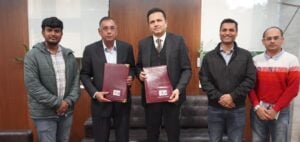Save electricity or gas in shops, offices or factories to avoid the risk of energy shortages during the winter? Even if nothing has been quantified yet, companies are multiplying initiatives to chase small and big waste.
Agri-food :
Fleury-Michon is building photovoltaic shades on the parking lots of all its plants.
“This will provide shade in the summer and allow us to produce some of our electricity consumption,” says the group, which says it has reduced its consumption of Kwh per kilo of product by 30% in about 10 years.
Distribution:
All food retailers – Carrefour, Intermarché, Système U, Auchan, Casino and Leclerc – have committed to turning off their illuminated signs at closing time as of October 15, to reducing light intensity before the public arrives and to lowering the ambient temperature of their outlets by one degree.
These everyday measures represent a 6% saving on the energy bill. Leclerc, in particular, began on September 12.
When it will be very cold, in the event of a peak in energy demand, exceptional measures have been proposed, such as reducing the temperature to 17 degrees during business hours, which allows for a “740 MW of shaving” or “a small nuclear power plant”, says the technical federation of distribution Perifem.
This protocol is extended to other businesses. For the moment in the non-food sector, the temperature of 17 degrees does not pass, because of the fitting rooms, but “if it is for two hours and to avoid a general blackout during a peak, it must be possible to think about it”, underlines Perifem.
The second major initiative is the installation of glass doors on the refrigerated product shelves, which reduces the energy bill by 25%. The process is still ongoing: 70% of the distributors are equipped, but there are still 30% that need to be.
The cost of installation – about one million euros for a medium-sized store – makes those who have not yet taken the plunge hesitate.
Industry:
The specter of gas cuts this winter is accelerating the race for solutions: heat recovery, switching to LED lighting or installing solar panels.
Toyota’s Onnaing plant has two projects: recovering heat from the compressors to heat the surface treatment baths before applying anti-corrosion treatment to the vehicles, and installing solar panels on five hectares of parking lots. Such a measure can achieve 10% energy savings, Toyota calculated.
The aluminum foundry of Saint-Jean Industrie (Belleville-en-Beaujolais) recovers heat from its furnaces to heat an entire sector of the plant. Since the end of 2021, the group has gained “between 10 and 15%” in electricity and gas, especially by monitoring its consumption in real time.
Michelin, which has reduced its energy consumption by 18% between 2010 and 2021, is continuing its efforts this winter. To save gas from its tire furnaces, the group is developing renewable energies, in particular biomass boilers (in Cholet and Bourges), photovoltaic energy (in Puy-en-Velay) and biomass heat purchases (in Vannes and Clermont-Ferrand).
In Troyes and Bassens, the group also buys heat, but from the incineration of household waste. In addition, this winter, the heating temperature of the offices and workshops “will not go beyond 19 degrees”, and will even fall to 17 degrees in the workshops where “physical efforts” are produced.
The group also has a plan to insulate its tertiary sites, and installs LEDs in its workshops and on the exterior lighting of its research center.
Veolia lowers the temperature of its premises and measures the consumption of each waste collection depot and each truck in order to identify corrective measures and deploy fuel-saving driving training.
Transportation:
The SNCF, a major consumer of electricity, has intensified its actions over the past few months by emphasizing “eco-driving”, a more flexible technique for driving trains, for example by taking advantage of the relief. This allows a reduction of up to 10% in energy consumption “without reducing (the) speed and therefore without penalizing passengers”, the Ministry of Transport points out.
The SNCF is also hunting for waste in industrial and tertiary buildings, installing LED lamps on a large scale and playing on the lighting and heating of stations.
But, the energy sobriety, at the SNCF, RATP and other transport operators, “it is not a plan to make fewer trains, even this winter,” assured the Minister of Transport Clement Beaune, reacting to rumors about the removal of trains to save energy.






















